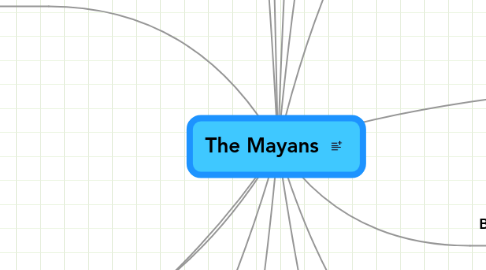
1. maintaining order of society and the balance of the two dimensions
2. Writing
2.1. Hieroglyphic Writing
2.1.1. like no other writing system
2.1.2. a number of simple word-pictures or a sophisticated phonetic system
2.1.3. combinations of only 26 signs—that list of letters we call an Alphabet.
2.2. Logographic Writing
3. The Collapse of the Maya
3.1. Theories
3.1.1. Ecological
3.1.2. Non-ecological
4. Government
4.1. Not a unified empire
4.1.1. A multitude of separate entities
4.2. Priest were the rulers also
4.2.1. Only priests/rulers/kings were allowed to be in the temples.
4.2.2. The priests lived in huge palaces.
4.2.3. Priests in small villages were the godfathers and assisted in births.
4.2.4. Priests led ceremonies like ch'acak to please the gods.ew node
4.3. hereditary= absolute monarchy
4.4. Taxes were paid
4.5. Crimes were punished with death
4.6. Social Hierarchy
4.6.1. Nobles
4.6.2. Commoners
4.6.3. Slaves
5. Religion
5.1. Gods
5.1.1. Itzamna
5.1.1.1. main god
5.1.1.2. brought his people maize and cacao and taught them script, healing, and the use of calendars
5.1.1.3. superhuman strength, stamina, vitality and resistance to injury. He also has the ability to tap into and manipulate mystical energies on the level of Zeus, Odin or Osiris
5.1.2. Kukulcan
5.1.2.1. god of resurrection and reincarnation
5.1.2.2. god of four elements, earth, water fire, air
5.1.3. Chac
5.1.3.1. rain god
5.1.3.2. associated with the wind god, Kukulcan
5.2. Rituals
5.2.1. Sacrifices
5.2.1.1. Bloodletting was a Mayan practice. Bloodletting is the cutting (not necessarily killing) of a person or animal to release blood. Source of blood dependent on the desired outcome of the ritual.
5.2.1.2. Small animals were used for smaller requests and big animals were used for more grand rituals.
5.2.1.2.1. Ex: Seventeen jaguars were sacrificed to dedicate a temple altar in the city of Copan.
5.2.2. Methods
5.2.2.1. Cutting throat, disemboweling, casting into a well, cutting open chest and removing a still beating heart.
5.2.3. Reasons
5.2.3.1. Bring rain, increase crops, and dedicate temples and ball courts.
5.3. Ball Courts
5.3.1. Much like modern day basketball
5.3.2. Winning captain would be decapitated. Considered a great honor. Winner would get a direct ticket to heaven instead of going through the 13 steps that the Mayan's believed they had to go through in order to reach heaven..
5.3.3. The field, size of football field, is bordered by two imposing walls 26 feet tall. Seven combatants on each team tried to get a small rubber ball to go through a small stone hoop 23 feet above the ground without using their hands or feet to touch the ball.
6. Technology
6.1. Math
6.1.1. Calendar
6.1.1.1. predict when the sun would set
6.1.1.2. what time of day it was
6.1.1.3. even predicted the world would end in 2012
6.1.2. numeral system
6.1.2.1. Three symbols
6.1.2.1.1. horizontal line, a dot and a oval symbol
7. Society
7.1. Class System
7.2. Clothing
7.3. Marriage
7.4. Hygiene
8. Military
8.1. Weapons
8.1.1. the bow and arrow, blowguns, spears, axes, knives with blades of volcanic glass , and spear-throwing slings called ‘atatls’.
9. Geography/topography
9.1. Central America
9.1.1. What is now Yucatan, Guatemala, Belize and southern mexico
9.2. Topography
9.2.1. volcanic mountains, which comprised the highlands in the South, to a porous limestone shelf, known as the Lowlands, in the central and northern regions
9.2.2. Lowlands- produced crops
9.2.3. Highlands- source of metals
10. Agriculture
10.1. Farming
10.1.1. Highlands
10.1.2. Lowlands
10.2. Crops
10.2.1. Maize
10.2.1.1. Preparation of maize
10.2.1.1.1. 1. Kernels boiled in lime
10.2.1.1.2. 2. Hominy ground into dough
10.2.1.1.3. 3. Dough made into 'tamales' or 'tortillas'
10.2.2. Beans
10.2.3. Squash
10.2.4. Chile peppers
10.2.5. Sweet manoic
11. Architecture
11.1. Pyramids
11.1.1. Made of Limestone and clay
11.1.2. Two types of Pyramids
11.1.2.1. Ones that where not meant to be climed
11.1.2.2. Ones that were meant to be climed
11.1.2.2.1. These where used for religious reasons
11.1.3. Used as landmarks, and sometimes a burial for high ranking Officials
11.2. Temples
11.2.1. Limestone and clay
11.2.2. were important to their ritual value
11.2.3. priest would preform their sacrifical ritual on these temples
11.2.4. Behind the plat form would be a picture of the god of that city
11.2.5. Each mayan city had one
11.3. Houses
11.3.1. Made out of organic material
11.3.1.1. Straw, Mud, Clay, Stone, Wood
12. Basic History and information
12.1. Dates
12.1.1. 10th millennium BCE
12.1.2. Mayan Time periods
12.1.2.1. Classic period
12.1.2.2. Pre-Classic
12.1.2.3. Post-Classic
12.2. Cities
12.3. Inventions
13. Economy
13.1. Primly crop
13.2. Food and agriculture
13.3. Farmers were a big part to the economy
13.3.1. Brought in food for the civilization
13.4. TRADE
13.4.1. Domesticated animals, crops, and jewelery
13.4.2. Farmers gave a portion of their crop away for wealth
13.4.3. small towns did not need to take part in long-distance trading
13.4.3.1. trade to local bartering and exchange
14. Art
14.1. Paintings
14.1.1. Mostly done in their books
14.1.2. On stone, walls, clothing, pottery, rocks ,and sometimes jade
14.1.3. Mainly painted on their wars, depressions and ceremonies
14.2. Jewelery
14.2.1. Most important for apperance
14.3. Apperance
14.3.1. Long necks
14.3.2. Flat heads
14.3.3. Hooked nose
14.4. Body art
14.4.1. Different colors of body paint
14.4.1.1. Priest wore blue, Warriors wore red and black, and the youth wore white
14.4.2. Piercings
